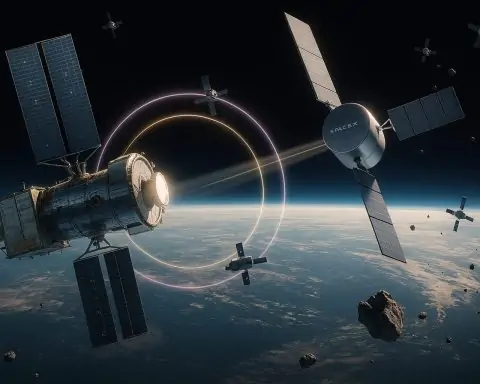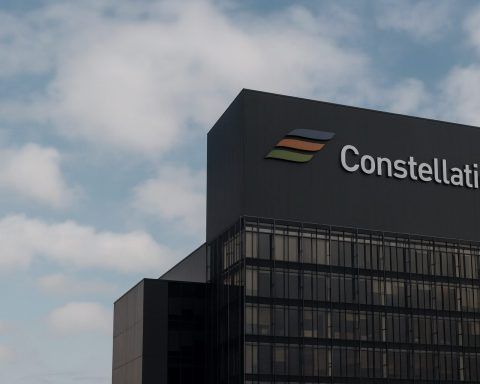Published November 25, 2025
As the first major cold fronts line up over North America, federal grid regulators are sounding the alarm: the explosive growth of AI data centers is helping push winter electricity demand to record highs — and in some regions, the power system may not be ready if a deep freeze hits. [1]
A new 2025–2026 Winter Reliability Assessment from the North American Electric Reliability Corporation (NERC) finds that winter peak demand on the bulk power system will be about 20 gigawatts higher than last year, while new resources to meet that demand have grown by less than half that amount. [2] Data centers built to power AI and cloud services, along with broader electrification of heating and transport, are a central driver of that surge. [3]
Under typical winter conditions, NERC expects most regions to have enough supply. But if a prolonged, wide‑area cold snap like 2021’s Winter Storm Uri or 2022’s Winter Storm Elliott hits, the watchdog warns that Texas, the Southeast, parts of the West, New England and the Pacific Northwest could all face supply shortfalls. [4]
At the same time, new reporting from outlets including CNBC/NBC (via Gizmodo), the Detroit Free Press and Utility Dive has zeroed in on a common theme: regions with heavy concentrations of AI and cloud data centers are disproportionately exposed when extreme cold collides with already‑strained grids. [5]
What NERC’s 2025–26 Winter Reliability Assessment actually says
NERC’s annual winter outlook is the closest thing the power sector has to a seasonal “state of the union.” This year’s message is blunt:
- Demand is rising faster than supply. Across the continent, NERC projects winter peak demand will be about 2.5% higher than last year — an increase of ~20 GW — while net resource additions total under 10 GW. [6]
- Most new capacity isn’t traditional power plants. Since last winter, the grid has added around 11 GW of battery storage and 8 GW of demand response, with only a few gigawatts of new thermal and hydro plants. Wind’s “counted” contribution has actually fallen because of changes in how capacity is credited. [7]
- Risk is concentrated in a handful of fast‑growing regions. NERC highlights the U.S. West, Southeast and Mid‑Atlantic — areas where data center development is booming — as seeing some of the steepest increases in winter peak demand. [8]
- Extreme cold remains the wild card. Under normal conditions through February, the assessment sees adequate resources. But multi‑day deep freezes that hit several regions at once could push Texas (ERCOT), the Southeast, New England, and parts of the West and Pacific Northwest into emergency territory. [9]
NERC also stresses that natural gas remains a vulnerability. Despite better coordination since Uri, gas production and pipelines can still freeze, cutting fuel to power plants right when heating demand spikes. [10]
Texas: AI server farms on a collision course with a fragile grid
No state illustrates the high‑stakes clash between AI growth and grid reliability quite like Texas.
A data center boom on a “knife‑edge” system
Gizmodo reports that Texas now hosts more than 400 data centers, second only to Virginia’s “data center alley.” [11] These facilities run 24/7 at massive loads, and they’re multiplying quickly:
- In November, projects requesting to connect to ERCOT’s grid reached about 220 GW of capacity — a 170% jump from 83 GW in January — and roughly 73% of that queue is data centers. [12]
- ERCOT and state officials have repeatedly warned that peak demand could nearly double by 2030, driven by large loads like data centers, crypto mining and hydrogen production. [13]
In its winter assessment, NERC singles out Texas RE‑ERCOT, the region overseen by ERCOT, for “continued risk of reserve shortages” during peak and high net‑load hours if extreme cold coincides with high demand. [14]
Because data centers seldom dial back consumption, their nonstop draw “alters the daily load shape” and lengthens the hours when demand stays near the peak, leaving operators with less breathing room if plants trip offline or wind and solar output sag in icy weather. [15]
Haunted by February 2021
The concern isn’t theoretical. During Winter Storm Uri in 2021, more than 4.5 million Texas customers lost power, hundreds of people died, and billions of dollars in damage followed when gas infrastructure froze and power plants failed en masse. [16]
NERC’s latest assessment notes that winterization rules, new battery storage, and demand‑response programs have improved the situation. But with data center‑driven demand rising quickly, the watchdog says the system is still at risk if the state sees another multi‑day Arctic blast. [17]
Local pushback and big‑tech workarounds
The Texas story is no longer just about grid engineers; it’s also about politics and land use:
- Investigative coverage has highlighted how AI and cloud campuses are driving up local electricity and water demand, sometimes in drought‑prone regions already asking residents to conserve. [18]
- Some utilities are racing to add gas plants, transmission lines and battery projects, while others are encouraging or requiring large customers to build their own dedicated power plants or microgrids to avoid overloading shared infrastructure. [19]
At the same time, developers defend the build‑out as a jobs and investment bonanza — a tension that’s now at the center of Texas’ energy politics.
Michigan and the Midwest: Not in the “highest‑risk” club, but not off the hook
The Detroit Free Press highlighted NERC’s conclusion that data center‑heavy regions are at the greatest risk of winter power shortfalls, but also noted that the bulk‑power region including Michigan (largely the MISO grid) is not in NERC’s highest‑risk category this winter. [20]
MISO’s winter picture
The Midcontinent Independent System Operator (MISO), which runs the grid from the Gulf Coast up through Michigan and parts of Canada, expects peak winter demand around 103 GW, with a “high” scenario near 109 GW. The operator says it is prepared for those levels under typical weather, though it stresses that risks remain. [21]
In fact, a recent filing by Michigan’s attorney general points out that in NERC’s latest winter assessment MISO is classified as “normal risk,” the lowest of NERC’s risk levels, even as other regions are flagged as elevated. [22]
Yet that doesn’t mean the Midwest can relax:
- The Department of Energy recently issued an emergency order extending the life of Michigan’s J.H. Campbell coal plant through February 2026 to shore up reliability after earlier outages on the MISO grid. [23]
- NERC and federal officials have warned that reliance on aging coal and gas plants, combined with rising electrification and growing industrial loads, continues to pose challenges in the region, especially if multiple plants fail during a cold snap. [24]
For Michigan, the bottom line this winter is nuanced: the state sits on a grid region that’s in better shape than some southern and western counterparts, but it’s still tied into a national system under accelerating stress from new large loads — data centers among them.
Pacific Northwest, Mid‑Atlantic and the Southeast: Data center hubs in the “crosshairs”
Beyond Texas and the Midwest, NERC’s warning has put other data‑center‑rich regions under the microscope.
Pacific Northwest
A widely syndicated report from The Center Square, summarized by Ground News, notes that NERC has added the Pacific Northwest to its list of areas at “elevated risk” for winter blackouts. [25]
Key factors:
- Winter peak demand in the PNW is projected to rise about 9.3%, driven by new data centers and electrification (including heat pumps and EVs). [26]
- Wind and solar often underperform in extended cold snaps, while hydropower — normally a strength — can be constrained by low river flows or operational limits. [27]
“Data center alley” and the Southeast
In the Mid‑Atlantic, northern Virginia’s “data center alley” has become the poster child for how continuous server‑farm demand stretches the evening peak into an extended plateau, making it harder for grid operators to maintain reserves. [28]
According to NERC and follow‑up reporting by Reuters and Business Insider:
- The Mid‑Atlantic (PJM), Southeast, and parts of the Western U.S. are all seeing some of the steepest growth in winter peak demand, much of it tied to data centers, semiconductor plants and other large industrial loads. [29]
- Under severe cold, regions like Tennessee, the Carolinas, Texas and Oklahoma could face heightened outage risks, the Free Press and other outlets have reported. [30]
In other words, the map of winter blackout risk now closely overlaps with the map of AI and cloud infrastructure build‑out.
Why AI data centers are so hard on winter grids
Not all electricity demand is created equal. AI‑era data centers bring several characteristics that make winter planning especially tricky.
1. Constant, high, “sticky” load
Unlike many industrial facilities, modern hyperscale data centers:
- Run 24 hours a day at very high utilization.
- Are designed for extremely high reliability; operators are reluctant to curtail compute workloads, even when the grid is stressed.
NERC’s winter assessment notes that this kind of round‑the‑clock operation flattens what used to be a sharp peak into a long plateau of high demand, leaving fewer low‑load hours to refill batteries, build reserves or take plants offline for maintenance. [31]
2. Winter is already the toughest season
In cold snaps, electricity demand jumps as:
- Electric heating systems ramp up.
- Gas‑fired power plants compete with home and building heating for limited natural gas supply.
- Wind turbines and other equipment can be impaired by ice, while short winter days cut solar output. [32]
Piling continuous data center demand on top of that makes it more likely that even a few plant outages or fuel bottlenecks could push a region into rolling blackouts.
3. Bigger climate and local‑impact footprint
Beyond reliability, several recent analyses highlight the environmental and local‑infrastructure burden of the AI build‑out:
- The Independent, citing NERC and recent research, reports that the U.S. already hosts more than 5,200 large data centers, with roughly 56% of their electricity coming from fossil‑fuel‑based generation, accounting for around 105 million metric tons of CO₂ — roughly 2% of total U.S. emissions. [33]
- A High Country News investigation finds that in California alone, data centers consumed about 10.8 TWh of electricity in 2023, enough to power ~1 million homes, while directly and indirectly using more than 13 billion gallons of water for cooling and power generation. [34]
Other studies suggest that by 2030, U.S. data centers could use up to 9% of national electricity generation, roughly double today’s share — and a significant chunk of that growth is being driven by AI workloads. [35]
How grid operators and policymakers are responding
The picture isn’t entirely bleak. Across the country, utilities, regulators and tech companies are trying to get ahead of the crunch — though often playing catch‑up.
Adding flexible resources
Because large power plants take years to build, much of the near‑term response is focused on flexibility:
- Since last winter, the grid has added about 11 GW of battery storage and 8 GW of demand‑response, allowing operators to shave peaks and fill short‑duration gaps. [36]
- Microgrids that combine solar, storage and sometimes backup generators are spreading, especially at data centers, factories and critical facilities, to provide onsite backup when the main grid is stressed. [37]
Delaying fossil‑plant retirements and exploring new nuclear
While controversial, several states and utilities are delaying coal or gas plant closures to keep extra capacity on hand as data center loads ramp up:
- In the West, utilities in Arizona, Colorado and other states are looking at keeping coal units online longer or adding new gas plants specifically to serve growing data center demand. [38]
- In Michigan, DOE’s emergency order to keep the Campbell coal plant running through 2026 is explicitly framed as a winter reliability backstop. [39]
- Tech companies and utilities are also exploring small modular nuclear reactors (SMRs) and other advanced nuclear options to supply dedicated power to AI campuses, particularly in Texas and the interior West. [40]
NERC’s to‑do list before the deep freeze
In its winter assessment and follow‑up summary, NERC lays out a set of practical steps for grid operators and regulators, including: [41]
- Finish winterization and weatherization work on generators and critical grid equipment before December.
- Improve extreme‑cold load forecasting, recognizing that models have underestimated demand by as much as 25% in past events.
- Run fuel‑adequacy surveys and coordination drills with gas suppliers, especially in regions relying heavily on single‑fuel gas plants.
- Pre‑plan emergency procedures such as public conservation appeals, demand‑response events and, as a last resort, controlled load shedding.
The message between the lines: the margin for error is thinning, and cold‑weather preparation can no longer be a box‑ticking exercise.
What this winter means if you live near a data center hub
For people living in or near data‑center‑dense regions — North Texas, Northern Virginia, parts of Georgia and the Carolinas, the Phoenix metro, the Pacific Northwest, the Michigan and Ohio industrial corridor and others — the latest reports add a new layer of concern. [42]
A few practical takeaways:
- Short‑term: Under ordinary winter weather, NERC expects the grid to hold. The highest risks arise if an extended, multi‑day Arctic blast hits a data‑center‑heavy region, particularly one already flagged as “elevated risk” like Texas, parts of the Southeast, or the Pacific Northwest. [43]
- Medium‑term: If data center growth keeps outpacing new clean‑energy, storage and transmission projects, more regions could see emergency orders, delayed plant retirements and higher electricity rates to fund upgrades. [44]
For households and businesses, experts generally recommend the same basic winter‑reliability steps regardless of where you live: stay plugged into alerts from your utility, keep critical devices and backup power options ready where feasible, and have a plan for heating and communication in case of multi‑hour outages. Those measures become even more important if you’re in a region where AI and cloud campuses are rapidly coming online.
The tension at the heart of the AI boom
Behind the technical charts and acronyms, the story is simple: AI’s hunger for compute is colliding with the limits of an aging, weather‑stressed power system.
On one side, AI and cloud companies argue that their infrastructure will unlock massive economic and social benefits, from medical breakthroughs to new industries and jobs. On the other, regulators and communities increasingly worry that the same infrastructure could raise bills, extend the life of fossil‑fuel plants and increase the risk of deadly winter outages if the build‑out isn’t matched by smarter planning and investment. [45]
NERC’s 2025–26 winter warning, the Texas‑focused reporting from CNBC/NBC and Gizmodo, the regional look from the Detroit Free Press, and analysis from outlets like Utility Dive all point in the same direction: data centers are no longer just an IT story — they’re a central player in America’s winter energy security. [46]
How quickly policymakers, utilities and tech giants can rebalance that equation will help determine whether the lights — and the heat — stay on the next time an Arctic blast descends.
References
1. www.utilitydive.com, 2. www.utilitydive.com, 3. www.utilitydive.com, 4. www.utilitydive.com, 5. gizmodo.com, 6. www.utilitydive.com, 7. www.utilitydive.com, 8. www.utilitydive.com, 9. www.utilitydive.com, 10. electricenergyonline.com, 11. gizmodo.com, 12. rcrtech.com, 13. www.texastribune.org, 14. www.nerc.com, 15. www.nerc.com, 16. flutrackers.com, 17. www.utilitydive.com, 18. www.hcn.org, 19. www.reuters.com, 20. www.freep.com, 21. www.misoenergy.org, 22. www.michigan.gov, 23. www.coalzoom.com, 24. www.countoncoal.org, 25. ground.news, 26. ground.news, 27. ground.news, 28. www.businessinsider.com, 29. www.utilitydive.com, 30. www.the-independent.com, 31. www.nerc.com, 32. www.utilitydive.com, 33. www.the-independent.com, 34. www.hcn.org, 35. www.utilitydive.com, 36. www.utilitydive.com, 37. www.reuters.com, 38. www.hcn.org, 39. www.coalzoom.com, 40. www.reuters.com, 41. electricenergyonline.com, 42. www.businessinsider.com, 43. www.utilitydive.com, 44. www.hcn.org, 45. www.hcn.org, 46. gizmodo.com










